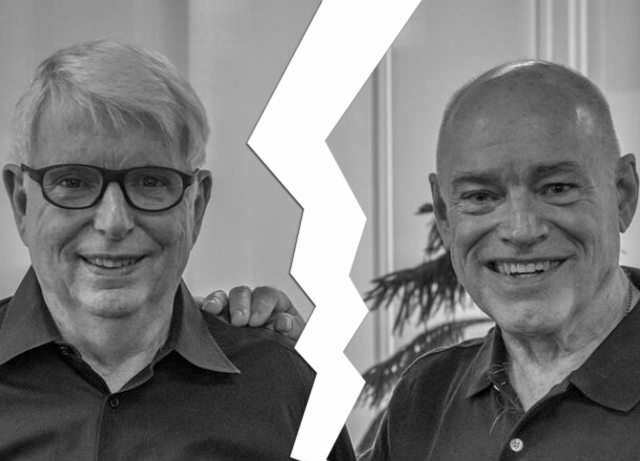During a recent Scrum training I enquired about the different Scrum certificates. I have attained a lot of certificates through Scrum.org, but I know that the Scrum Alliance also gives out their own certificates. The response of my (Scrum.org licenced) trainer was a little more dramatic than I initially expected. They shared their insights on a divided Scrum landscape – a Scrum schism, so to speak. Quite typically (and banally) money appears to be the driving force.

Surprisingly, this circumstance parallels the biblical story of Babel. Scrum, like Babel, began with unity. It used a common language to promote efficient and productive software development. However, economic interests quickly took over. As in the biblical story, this led to conflicts. The discourse now divided over a single issue: certification. In this post, I will shed light on this schism and attempt to explain how it occurred.
A tale of two creators
Scrum was introduced to the public in 1995 by Jeff Sutherland and Ken Schwaber. Being two veterans of the Vietnam War, they experienced their everyday risk assessments greatly influenced their thought processes, and subsequently their work. Their similar experiences and related career paths eventually led to the development of Scrum. Sutherland and Schwaber attended a meeting in Utah in 2001, organized by 17 supporters of lightweight software development approaches. This gathering, dubbed the “Light Weight Methods Conference” at first, culminated in the creation of a unifying term for their common ethos, Agile. The ‘Agile Manifesto’, an expression of their collective beliefs and values, was formed, and its authors began to refer to themselves as the Agile Alliance.
The Agile Alliance, a non-profit organization that is framework-agnostic, hosts yearly events and cultivates a network of coaches. This organization acts as a hub for several agile methodologies, guaranteeing the diversity of the Agile community. It does not, however, provide certification pathways, instead focused on promoting professional awareness and skill development.
Certification and profit
Schwaber, one of Scrum’s inventors, co-founded the Scrum Alliance in 2002. This non-profit group swiftly launched the Certified Scrum Master (CSM) credential, which was well received. However, seven years after its inception, Schwaber quit the Scrum Alliance due to differences about the certification programs that had fueled Scrum’s initial development. Despite this, the Scrum Alliance has thrived, offering a variety of certification options.
Schwaber started Scrum.org in 2009 after leaving the Scrum Alliance. His goal was to improve Scrum understanding, training, and implementation. Scrum.org provides a certification series (PSM, PSPO, PSD, etc.) that emphasizes on self-study and online tests. Nexus, a Scrum-based scalability framework, was also introduced.
For Scrum Alliance’s CSM certification, attending a training session is mandatory. After the session, candidates take the test. In contrast, Scrum.org allows individuals to take (some) exams without mandatory training. Scrum Alliance certificates require renewal every two years. For this, individuals need to earn Scrum Education Units (SEUs) and pay a renewal fee. However, Scrum.org certifications last a lifetime. Once you achieve them, they don’t expire. Furthermore, Scrum Alliance emphasizes the community-driven learning approach. They focus on collaborative learning and sharing experiences. Scrum.org, meanwhile, leans toward a standardized curriculum. They believe in consistency in Scrum knowledge and practices.
Scrum Alliance’s certification pathways have been criticized for placing too much emphasis on paid training, prompting some to doubt the organization’s non-profit status. On the other side, they encourage continuing professional growth by offering Scrum Education Units (SEUs) for actions that improve Scrum expertise.
In contrast to Schwaber, Jeff Sutherland established the for-profit ScrumInc in 2006. Scrum@Scale, another scaling framework, was created by his firm. ScrumInc offers Scrum@Scale training and certification, with course completion contributing to Scrum Alliance certification routes.
Honoring the spirit of Scrum
So, many different factions with different approaches. Fortunately, the Scrum Guide provides a common reference point among the enormous variety in different Scrum interpretations and implementations. Sutherland and Schwaber (freely) published the Scrum Guide in 2010 as a simplified version of their shared expertise and opinions.
As Scrum practitioners, we find ourselves in the thick of this complication. The differences in certification between Scrum.org and Scrum Alliance bring complexity to the decision-making process. The presence of various certification options can create confusion. Potential certificants might struggle to determine which certification aligns best with their career aspirations and learning styles. Those seeking certification should weigh the implications to determine the best path for their needs.
Despite this Scrum schism, we should not lose sight of our shared aim. We intend to abandon established development methodologies for complex projects. Our goal is to develop in a more agile, inclusive, and efficient manner. This same purpose unites us all and extends beyond economic interests and certifications. We honor the Scrum spirit when we transcend above these. After all, that would resonate with the original Agile Manifesto’s call for simplicity and collaboration.
